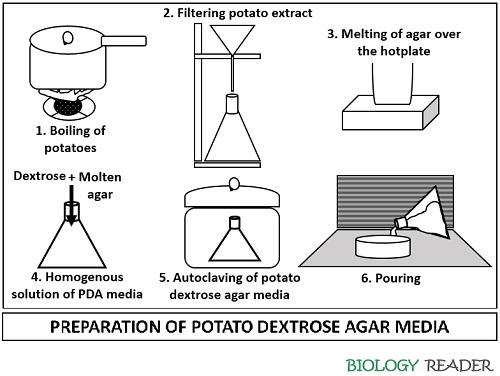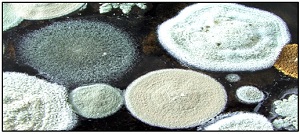Potato dextrose agar media is primarily exercised for the growth and isolation of different yeasts and moulds. It can be practised in the form of a liquid broth and solid culture medium.
PDA media serves as an ordinary growth medium for the yeasts and moulds, but it can be made selective by incorporating selective agents like tartaric acid, chloramphenicol etc.
PDA media comprises potato infusion and dextrose sugar that gives a nutrient base and the carbohydrate source, respectively, for the fungal growth.
In this post, we will discuss the principle, appearance, composition, role of the chemical constituents, media preparation of the potato dextrose agar media. Also, the storage, results, uses and limitations of the PDA media have been explained.
Content: Potato Dextrose Agar
Principle of Potato Dextrose Agar Media
Potato dextrose agar media principally works as the ordinary or selective medium, which determines the growth or presence of different yeasts and fungi from the different samples that are important for sanitary purpose, especially food products.
It can be supplemented with selective agents like acids and antibiotics (chloramphenicol, tartaric acid and chlortetracycline) that restrict bacterial growth that may interfere with the fungal growth. Potato dextrose agar media is clinically significant for the culturing, isolation and maintenance of fungi (like yeasts and moulds).
Appearance
- In dehydrated form: The potato dextrose broth appears as a homogenous solution and light amber in colour.
- In prepared form: Potato dextrose agar media appears slightly opalescent and light amber in colour.
Potato Dextrose Agar Composition
The ingredients of the potato dextrose agar media in 1 L of distilled water include:
- Potato: 200 g
- Dextrose: 20 g
- Agar: 20 g
Potato dextrose agar is supplemented with some selective agents, which quantity for the 1 L of deionized water includes:
- Chlortetracycline: 40.0 mg
- Chloramphenicol: 25.0 mg
- Tartaric acid: 1.4 g
Role of Media Components
The potato infused in PDA medium supplies the nutrient base for the development of yeasts and moulds. Dextrose is a fermentable carbohydrate that supplies a sole C-source to promote fungal growth.
Agar acts as a solidifying agent of the media. The selective antibiotics and organic acids in PDA inhibit bacterial growth. TA (Tartaric acid) in the PDA medium enumerates the microbe’s presence in food and dairy products.
Sometimes, antibiotic like chlortetracycline serves as a selective agent that enumerates the microbial population from cosmetics. Chloramphenicol is also an antibiotic that supports fungal cultivation from mixed samples.
Preparation of PDA Media
The preparation of potato dextrose agar media follows the given protocol:

Potato Infusion
To infuse 200 grams of potato in the PDA media, we need to follow the following steps:
- Firstly, wash the potatoes, followed by peeling and weighing, cut the potatoes into small pieces.
- Then, cook the chopped potatoes in 500 ml of distilled water for 20 minutes in a pressure cooker.
- Collect the potato extract into the conical flask by using a muslin cloth or net filter.
Melting of Solid Agar
- After this step, add 20 grams of agar into the pressure cooker along with 500 ml of distilled water for about 30 minutes.
Mixing of media components
- Weigh 20 grams of dextrose accurately and add it into a sterilized conical flask having potato extract.
- Finally, thoroughly mix the molten agar with the potato dextrose mixture and make the volume to 1 litre by adding distilled water.
- Then, put a cotton plug into the mouth of the conical flask to avoid any contamination.
Autoclaving or Sterilization
- After getting a homogenous solution, subject the flask to autoclave sterilization at 15 lbs pressure for 20 minutes.
- Then, take out the flask from the autoclave directly to the laminar airflow chamber to perform plating. You can keep the remaining media in a refrigerator for further use.
Checking of pH
Before plating, check the pH of the media by dipping one end of a small piece of litmus paper into the medium. Then take out the litmus paper and compare the colour formed with the colour chart of the litmus paper book.
- If the pH is above 7, we need to add a few drops of 0.1N HCl to make the pH of the media neutral.
- If the pH is below 7, we need to add a few drops of 0.1 N NaOH to make the pH of the media to 7 or neutral.
Storage
Ideally, the PDA media must be kept under refrigeration (at 2-8 degrees Celsius). If there is cracking, discolouration or any other signs of contamination, then the media must be discarded. The media should be kept away from the direct light.
Result Interpretation
The result can be indicated by the growth of fungi in the culture media.

- Yeasts: They develop as creamy white colonies.
- Moulds: They appear as filamentous colonies with different margins, colours and texture over the culture media.
Uses
- Potato dextrose agar detects the presence of fungal biomass in dairy and prepared food products.
- Potato dextrose agar with tartaric acid examines microbes attacking food and dairy products.
- PDA media with chlortetracycline enumerates yeast and mould counts from cosmetics.
- Potato dextrose agar with chloramphenicol selectively supports the growth of fungi from the mixed samples.
Limitations
PDA media only detects the presence or absence of multicellular fungi, but the isolated fungi require biochemical, immunological, molecular, or mass spectrometry testing for the confirmed identification.
may i know what kind of dextrose is used? thank you! will any kind of dextrose powder can be used?
Is there more than one type of dextrose? If it is dextrose, you can use it. It doesn’t matter what brand it is.